
Concept explainers
(a)
Interpretation:
Lewis structure of formate ion
Concept Introduction:
Lewis structure represents covalent bonds and describes valence electrons configuration of atoms. The covalent bonds are depicted by lines and unshared electron pairs by pairs of dots. The sequence to write Lewis structure of some molecule is given as follows:
- The central atom is identified and various other atoms are arranged around it. This central atom so chosen is often the least electronegative.
- Total valence electrons are estimated for each atom.
- single bond is first placed between each atom pair.
- The electrons left can be allocated as unshared electron pairs or as multiple bonds around
symbol of element to satisfy the octet (or duplet) for each atom. - Add charge on the overall structure in case of polyatomic cation or anion.
(a)
Explanation of Solution
The molecule
The symbol for carbon is
The symbol for hydrogen is
The symbol for oxygen is
One negative charge on molecule is added up as one valence electron in the total count.
Thus total valence electrons are sum of the valence electrons for each atom in
The skeleton structure
To complete the valence electrons of carbon, it forms a double bond with one oxygen atom.
Hence, 10 electrons are allocated as 3 lone pairs on singly bonded oxygen atom and two lone pairs on doubly bonded oxygen atom. The Lewis structure of
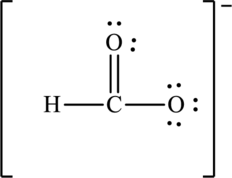
The negative charge on molecule is delocalized on each oxygen atom and since there are two oxygen atoms, therefore, two resonance structures are formed and possible resonance structures are as follows:

(b)
Interpretation:
Lewis structure of hydrogen phosphite ion
Concept Introduction:
Refer to part (a).
(b)
Explanation of Solution
The molecule
The symbol for oxygen is
The symbol for hydrogen is
The symbol for phosphorus is
Two negative charges on molecule are added up as two valence electrons in the total count.
Thus total valence electrons are sum of the valence electrons for each atom in
The skeleton structure
Hence, 18 electrons are allocated as 3 lone pairs on two singly bonded oxygen atoms and 2 lone pairs on doubly bonded oxygen atom to complete their octet. The Lewis structure is as follows:
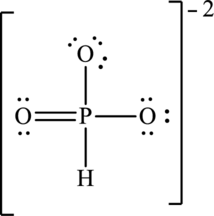
The negative charge on molecule is delocalized on three oxygen atoms therefore three resonance structures will be formed and possible resonance structures are as follows:

(c)
Interpretation:
Lewis structure of bromate ion
Concept Introduction:
Refer to part (a).
(c)
Explanation of Solution
The molecule
The symbol for oxygen is
The symbol for bromine is
One negative charge on molecule is added up to the total valence count.
Thus total valence electrons are sum of the valence electrons for each atom in
The skeleton structure
To complete the valence electrons of bromine it forms two double bonds with two oxygen atoms.
Hence, 16 electrons are allocated as 3 lone pairs on the singly bonded oxygen atom, 2 lone pairs on doubly bonded oxygen atom and 1 lone pair on bromine to complete their respective octet. The Lewis structure is as follows:
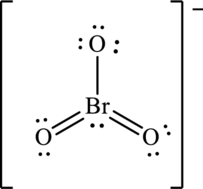
The negative charge on molecule participates in resonance by resonating on each oxygen atom. Since there are three oxygen atoms, therefore three resonating structures are drawn as:

(d)
Interpretation:
Lewis structure of selenate ion
Concept Introduction:
Refer to part (a).
(d)
Explanation of Solution
The molecule
The symbol for oxygen is
The symbol for selenium is
Two negative charges on molecule are added up as two valence electrons in the total count
Thus total valence electrons are sum of the valence electrons for each atom in
The skeleton structure
To complete the valence electrons of selenium, it forms double bond with two oxygen atom.
Hence, 20 electrons are allocated as 3 lone pairs on singly bonded oxygen atoms and 3 lone pairs on doubly bonded oxygen atoms to complete their octet. The Lewis structure is as follows:
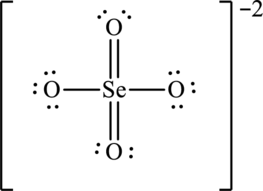
The two negative charges on molecule are delocalized on two oxygen atoms and since there are four oxygen atoms, therefore, four resonance structures will be formed and possible resonance structures are as follows:
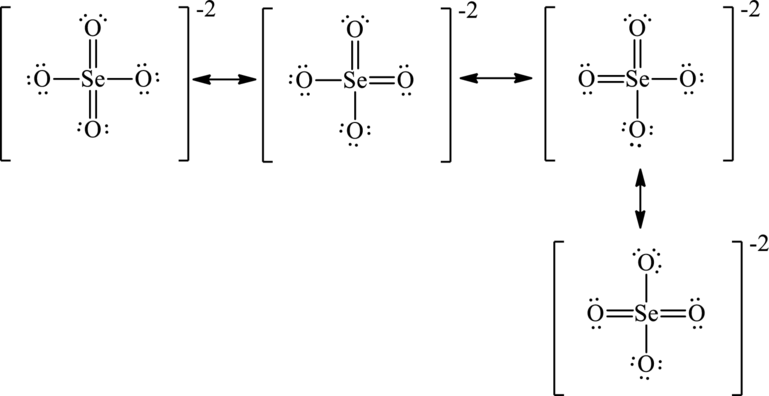
Want to see more full solutions like this?
Chapter 2 Solutions
Chemical Principles: The Quest for Insight
- Using wedge-and-dash bonds, modify the bonds on the chiral carbon in the molecule below so the molecule has R stereochemical configuration. NH H Br X टेarrow_forwardProvide photos of models of the following molecules. (Include a key for identification of the atoms) 1,2-dichloropropane 2,3,3-trimethylhexane 2-bromo-3-methybutanearrow_forwardPlease draw the structure in the box that is consistent with all the spectral data and alphabetically label all of the equivalent protons in the structure (Ha, Hb, Hc....) in order to assign all the proton NMR peaks. The integrations are computer generated and approximate the number of equivalent protons. Molecular formula: C13H1802 14 13 12 11 10 11 (ppm) Structure with assigned H peaks 2.08 3.13arrow_forward
- A 0.10 M solution of acetic acid (CH3COOH, Ka = 1.8 x 10^-5) is titrated with a 0.0250 M solution of magnesium hydroxide (Mg(OH)2). If 10.0 mL of the acid solution is titrated with 10.0 mL of the base solution, what is the pH of the resulting solution?arrow_forwardFirefly luciferin exhibits three rings. Identify which of the rings are aromatic. Identify which lone pairs are involved in establishing aromaticity. The lone pairs are labeled A-D below.arrow_forwardA 0.10 M solution of acetic acid (CH3COOH, Ka = 1.8 x 10^-5) is titrated with a 0.0250 M solution of magnesium hydroxide (Mg(OH)2). If 10.0 mL of the acid solution is titrated with 10.0 mL of the base solution, what is the pH of the resulting solution?arrow_forward
- Given a complex reaction with rate equation v = k1[A] + k2[A]2, what is the overall reaction order?arrow_forwardPlease draw the structure in the box that is consistent with all the spectral data and alphabetically label all of the equivalent protons in the structure (Ha, Hb, Hc....) in order to assign all the proton NMR peaks. The integrations are computer generated and approximate the number of equivalent protons. Molecular formula: C13H1802 14 13 12 11 10 11 (ppm) Structure with assigned H peaks 2.08 3.13arrow_forwardCHEMICAL KINETICS. One of the approximation methods for solving the rate equation is the steady-state approximation method. Explain what it consists of.arrow_forward
- CHEMICAL KINETICS. One of the approximation methods for solving the rate equation is the limiting or determining step approximation method. Explain what it consists of.arrow_forwardCHEMICAL KINETICS. Indicate the approximation methods for solving the rate equation.arrow_forwardTRANSMITTANCE เบบ Please identify the one structure below that is consistent with the 'H NMR and IR spectra shown and draw its complete structure in the box below with the protons alphabetically labeled as shown in the NMR spectrum and label the IR bands, including sp³C-H and sp2C-H stretch, indicated by the arrows. D 4000 OH LOH H₂C CH3 OH H₂C OCH3 CH3 OH 3000 2000 1500 HAVENUMBERI-11 1000 LOCH3 Draw your structure below and label its equivalent protons according to the peak labeling that is used in the NMR spectrum in order to assign the peaks. Integrals indicate number of equivalent protons. Splitting patterns are: s=singlet, d=doublet, m-multiplet 8 3Hb s m 1Hd s 3Hf m 2Hcd 2Had 1He 鄙视 m 7 7 6 5 4 3 22 500 T 1 0arrow_forward
 Chemistry: The Molecular ScienceChemistryISBN:9781285199047Author:John W. Moore, Conrad L. StanitskiPublisher:Cengage Learning
Chemistry: The Molecular ScienceChemistryISBN:9781285199047Author:John W. Moore, Conrad L. StanitskiPublisher:Cengage Learning
